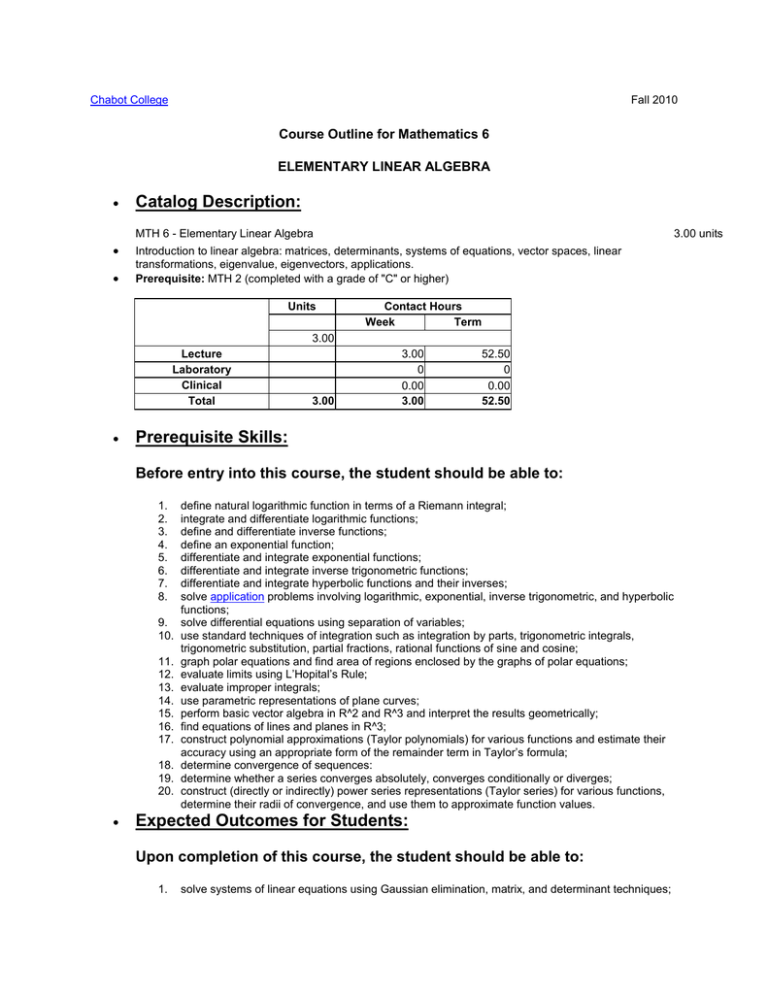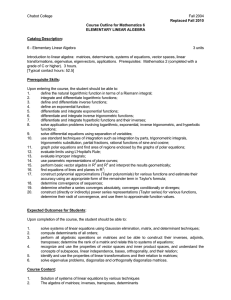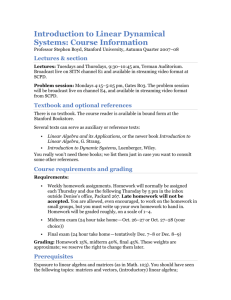Catalog Description: Course Outline for Mathematics 6 ELEMENTARY LINEAR ALGEBRA •
advertisement

Chabot College Fall 2010 Course Outline for Mathematics 6 ELEMENTARY LINEAR ALGEBRA • Catalog Description: MTH 6 - Elementary Linear Algebra • • 3.00 units Introduction to linear algebra: matrices, determinants, systems of equations, vector spaces, linear transformations, eigenvalue, eigenvectors, applications. Prerequisite: MTH 2 (completed with a grade of "C" or higher) Units Contact Hours Week Term 3.00 Lecture Laboratory Clinical Total • 3.00 3.00 0 0.00 3.00 52.50 0 0.00 52.50 Prerequisite Skills: Before entry into this course, the student should be able to: 1. 2. 3. 4. 5. 6. 7. 8. 9. 10. 11. 12. 13. 14. 15. 16. 17. 18. 19. 20. • define natural logarithmic function in terms of a Riemann integral; integrate and differentiate logarithmic functions; define and differentiate inverse functions; define an exponential function; differentiate and integrate exponential functions; differentiate and integrate inverse trigonometric functions; differentiate and integrate hyperbolic functions and their inverses; solve application problems involving logarithmic, exponential, inverse trigonometric, and hyperbolic functions; solve differential equations using separation of variables; use standard techniques of integration such as integration by parts, trigonometric integrals, trigonometric substitution, partial fractions, rational functions of sine and cosine; graph polar equations and find area of regions enclosed by the graphs of polar equations; evaluate limits using L’Hopital’s Rule; evaluate improper integrals; use parametric representations of plane curves; perform basic vector algebra in R^2 and R^3 and interpret the results geometrically; find equations of lines and planes in R^3; construct polynomial approximations (Taylor polynomials) for various functions and estimate their accuracy using an appropriate form of the remainder term in Taylor’s formula; determine convergence of sequences: determine whether a series converges absolutely, converges conditionally or diverges; construct (directly or indirectly) power series representations (Taylor series) for various functions, determine their radii of convergence, and use them to approximate function values. Expected Outcomes for Students: Upon completion of this course, the student should be able to: 1. solve systems of linear equations using Gaussian elimination, matrix, and determinant techniques; 2. 3. 4. 5. 6. • Course Content: 1. 2. 3. 4. 5. 6. • Solution of systems of linear equations by various techniques The algebra of matrices; inverses, transposes, determinants Vector spaces, subspaces, linear independence, bases, dimension, row and column space, inner product spaces, orthonormal bases, Gram-Schmidt Process Linear transformations, their properties and matrix representations, geometry of linear transformation, change of basis Eigenvalue problems, similarity, orthogonal bases, and diagonalizing matrices Applications: quadratic forms, the Principal Axes Theorem, approximation, Fourier series (if time permits) Methods of Presentation 1. 2. • compute determinants of all orders; perform all algebraic operations on matrices and be able to construct their inverses, adjoints, transposes; determine the rank of a matrix and relate this to systems of equations; recognize and use the properties of vector spaces and inner product spaces, and understand the concepts of subspaces, linear independence, bases, orthogonality, and their relation; identify and use the properties of linear transformations and their relation to matrices; solve eigenvalue problems, diagonalize and orthogonally diagonalize matrices. Lecture/Discussion Demonstration/Exercise Assignments and Methods of Evaluating Student Progress 1. Typical Assignments A. B. Find the standard matrix for the stated composition of linear operators on R^2. 1) A rotation of 90 degrees, followed by a reflection about the line y = x. 2) An orthogonal projection on the y-axis, followed by a contraction with factor k = 0.5. 3) A reflection about the x-axis, followed by a dilation with factor k = 3. Let V be an inner product space. Show that if w is orthogonal to both u1 and u2, it is orthogonal to k1u1 + k2u2 for all scalars k1 and k2. Interpret this result geometrically in the case where V is R3 with the Euclidean inner product. 2. Methods of Evaluating Student Progress A. B. C. • Textbook (Typical): 1. • Exams/Tests Quizzes Home Work Howard Anton (2009). Elementary Linear Algebra Wiley Publishing. Special Student Materials 1. A calculator may be required.






